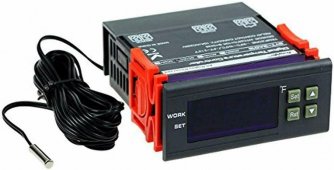Rbertalotto
Solar Enthusiast
- Joined
- Nov 26, 2019
- Messages
- 394
I stay in the high desert in New Mexico for the winter months. At night it can get down into the 20s and by 9AM it will be in the 70s. I recently installed two 100ah Lithium batteries into an insulated battery box I fabricated out of diamond plate aluminum.
Concerned that the batteries would not come up to charging temp once the sun rises and the charging begins, I decided to heat the battery compartment.
I decided to use a Falcon 7.25" X 25" RV Tank Heating Pad ($40). This pad has a built in thermostat that turns on the heater at 45 degrees and turns it off at 68 degrees. I wanted more control over the heat cycle so I removed the built in thermostat and installed a programable temperature control unit.
The first chore was to find one that was easily programable and the read out was in Fahrenheit........I went through two other very inexpensive and extremely hard to program and only read in Celsius. Then I found a beautiful unit, Bayite DC 12V Fahrenheit 10A Relay control ($18).
The heat pad has a removable paper that covers an extremely agressive adhesive used to secure the pad to the water tanks on an RV. I removed this paper and applied a layer of aluminum foil. I did not want to stick the pad directly to the batteries.
The pad was installed against the side of the batteries. The battery box has 3/4" closed cell foam all the way around the batteries for insulation.
I then wired it up to the controller and added an LED light to the exterior of the storage compartment where the controller lives. At a glance I can see if the heater is on or off.
As it turned out, once I had it installed, here in New England we went through extreme warm weather. The nights never got below 60 degrees, until last night.
Last night the temp went down to 27 degrees.
I have the controller set to turn on at 40 degrees and turn off at 50 degrees.
This morning at 5AM the battery temperature (From the Renogy battery internal blue tooth) was 53 degrees and the battery box itself was 51 degrees.
But to keep the battery at 50 degrees throughout the night used 17% of my 200ah battery bank.
I need to do the math if it might not be better to install another heat pad to bring the temperature up faster and not have to be on as long.
So, in conclusion, I'm very pleased on how this system works. When actually camping, I will disconnect the solar array at nightfall and shut the battery warmer off until 5AM the next morning. No reason to use battery storage to keep the batteries warm when not charging.
Looking forward to New Mexico i8n a few weeks!


Concerned that the batteries would not come up to charging temp once the sun rises and the charging begins, I decided to heat the battery compartment.
I decided to use a Falcon 7.25" X 25" RV Tank Heating Pad ($40). This pad has a built in thermostat that turns on the heater at 45 degrees and turns it off at 68 degrees. I wanted more control over the heat cycle so I removed the built in thermostat and installed a programable temperature control unit.
The first chore was to find one that was easily programable and the read out was in Fahrenheit........I went through two other very inexpensive and extremely hard to program and only read in Celsius. Then I found a beautiful unit, Bayite DC 12V Fahrenheit 10A Relay control ($18).
The heat pad has a removable paper that covers an extremely agressive adhesive used to secure the pad to the water tanks on an RV. I removed this paper and applied a layer of aluminum foil. I did not want to stick the pad directly to the batteries.
The pad was installed against the side of the batteries. The battery box has 3/4" closed cell foam all the way around the batteries for insulation.
I then wired it up to the controller and added an LED light to the exterior of the storage compartment where the controller lives. At a glance I can see if the heater is on or off.
As it turned out, once I had it installed, here in New England we went through extreme warm weather. The nights never got below 60 degrees, until last night.
Last night the temp went down to 27 degrees.
I have the controller set to turn on at 40 degrees and turn off at 50 degrees.
This morning at 5AM the battery temperature (From the Renogy battery internal blue tooth) was 53 degrees and the battery box itself was 51 degrees.
But to keep the battery at 50 degrees throughout the night used 17% of my 200ah battery bank.
I need to do the math if it might not be better to install another heat pad to bring the temperature up faster and not have to be on as long.
So, in conclusion, I'm very pleased on how this system works. When actually camping, I will disconnect the solar array at nightfall and shut the battery warmer off until 5AM the next morning. No reason to use battery storage to keep the batteries warm when not charging.
Looking forward to New Mexico i8n a few weeks!




